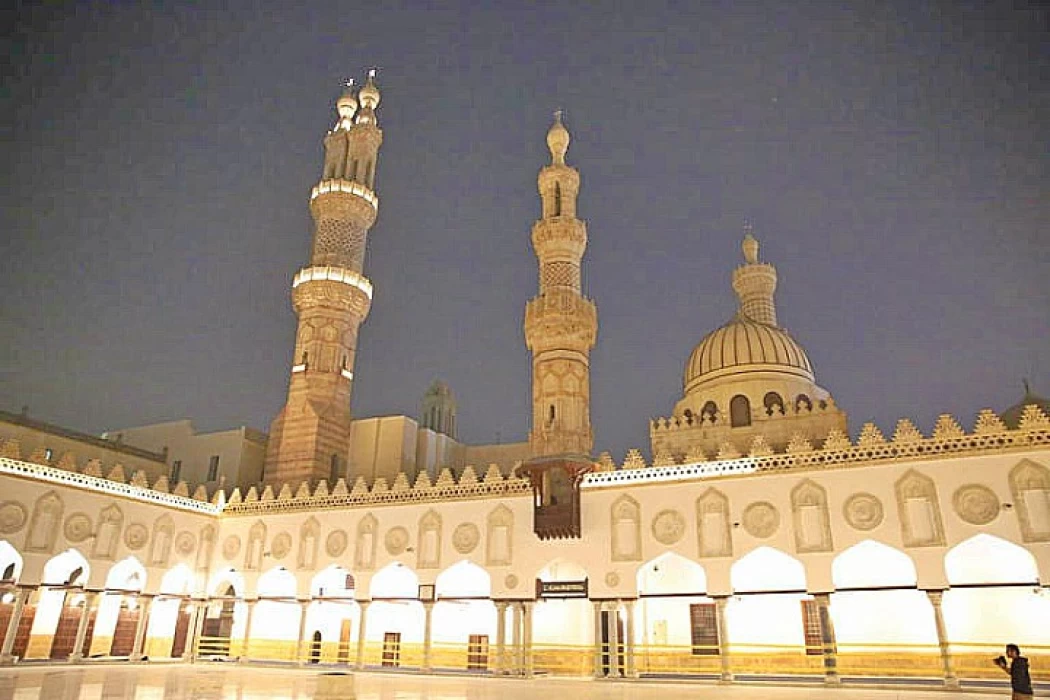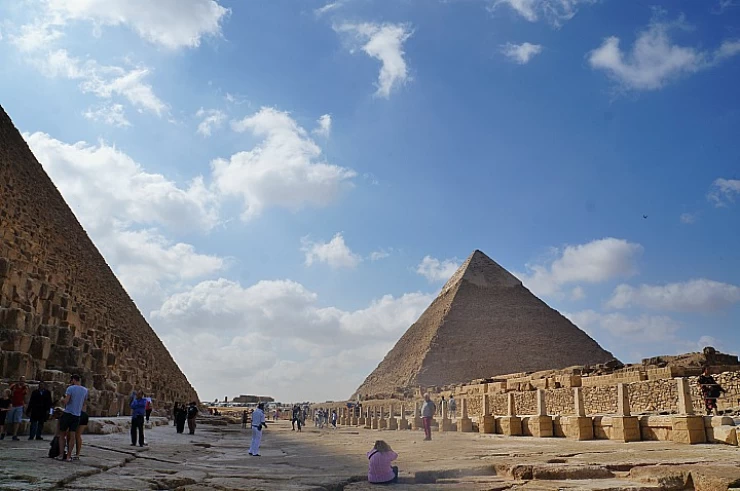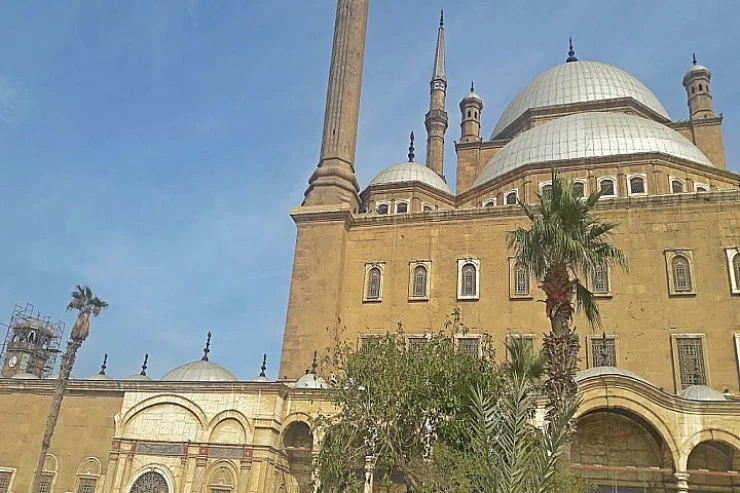
Al Azhar Mosque
Details About Al Azhar Mosque
The Al-Azhar Mosque was not called Al-Azhar at the beginning of its construction, but it was known as the Cairo Mosque in reference to the new Fatimid capital, and the name Al-Azhar Mosque occurred late, as historians close to the construction of Cairo, such as Al-Misbahi, Ibn al-Tuwair and Ibn al-Ma'mun, referred to it as the Cairo Mosque, and rarely referred to it as the Al-Azhar Mosque. The Cairo Mosque may have been named Al-Azhar Mosque after Fatima al-Zahra, the daughter of the Prophet and wife of Imam Ali bin Abi Talib, to whom the Fatimids are affiliated, and it was said that it was named so in anticipation of the importance and prestige it would have by the flourishing of science in it.
Imam Al-Aziz Billah (365-386 AH/975-996 AD) took an interest in it and renovated some parts of the southeastern portico (Qibla canopy and its decoration), and Imam Al-Hakim Amrullah (386-411 AH/996-996 AD) took an interest in the construction of the Al-Azhar University. 1021 AD) took care of the architecture of the mosque, renewed its minaret, raised its roof a cubit higher than it was, and a huge wooden door remains from his work, which is currently preserved in the Museum of Islamic Art in Cairo, and arranged for it in 400 AH/1009 AD, along with some other Fatimid facilities, endowments to be spent from its revenues on its administration and affairs, which was the first endowment arranged for the Al-Azhar Mosque.
The Fatimid mosque, built by Commander Gohar al-Sicilian, consisted of a rectangle measuring 70 x 88 m2, consisting of a rectangular celestial nave surrounded by three canopies on three sides only. Since the width of the mihrab portico is not equal to the width of the basement, the architect had to narrow it where it meets the axis with additional columns to create a square that holds the dome of the mihrab.
Pointed arches were used to raise the roof of the First Fatimid Mosque, similar to the arches used in the Tuluni Mosque, although the pointed arches are more prominent than in the arches of the Tuluni Mosque. Pointed arches have Sassanian origins, with the earliest examples found in the Taq Kisra in Iraq, dating back to the era of King Shapur I (242-272 AD), and the earliest example of them in Islamic architecture found in the façade of the Majaz overlooking the nave of the Umayyad Mosque in Damascus in 96H/714 AD.
One of the methods of building inclusive mosques is the multiple niches, a technique found in North Africa, especially those niches that overlook the nave, where those who repeat the takbirs of the imam stand so that worshippers can hear him outside the qibla canopy. The oldest examples of these wooden niches were found in the Uqba Mosque in Kairouan, while the oldest known example of multiple niches in the qibla wall was found in the mosque of St. Catherine's Monastery, where there are three niches dating back to the era of Prince Abu al-Mansur Anushtekin who built the mosque between 429 - 433 AH and 437 - 1041 AD of the Fatimid era. 433 AH and 1037-1041 AD of the Fatimid era.
The movable pulpit is a Moroccan influence that appeared in the Zaytuna Mosque in Tunis, the Sfax Mosque, and the Monastir Mosque. The Mamluk era is considered one of the most prosperous and best eras in which Al-Azhar lived, as the Mamluk rulers raced to take care of Al-Azhar, students, elders and architecture, and expanded spending on it, attention and even adding to its architectural structure.
In the Ottoman era, the Ottoman sultans showed great respect for the mosque and its people, despite its resistance to them and standing with the Mamluks during their war with the Ottomans, but this respect was not practically translated in the form of care and attention to its architecture or spending on its sheikhs and students.
However, during this period, the mosque became the best place for all Egyptians to learn science and religious knowledge, and it became the center of the largest gathering of Egyptian scholars and began to teach some of the sciences of philosophy and logic for the first time.
Throughout the ages, from its inception to the present time, Al-Azhar Mosque has enjoyed the attention of caliphs, sultans, princes and rulers to its architecture in terms of expansion, construction and restoration, especially the Mamluk era, the last of which was the comprehensive restoration work that was completed in 1439 AH / 2018 AD, which lasted about three years, with an area of approximately 12 thousand square meters.
Al Azhar Mosque |
Al Azhar house of prayer is one of the wonderful mosques and things to do in Cairo, it considered is the primary University in history engineered over one thousand years past in Cairo, folks visiting Khan El Khalili can see the house of prayer throughout their Cairo Day Tours. it had been towards the tip of the tenth century to be the official house of prayer for the congregational prayers control each Friday and is thought in a very rabic as Jummah.
The developer of the fascinating house of prayer of Al Azhar is as previous because the town of Cairo itself is additionally the good Fatimid army leader and also the builder of Cairo, Gawhar El Seqelly, with the orders of the Fatimid caliph, Al Mui'z le Din Allah. The building of Al Azhar that needs to be seen throughout the regular Egypt Travel Packages or Cairo day tours from the Airport began in 970 A.D. and it took around 3 years to be accomplished.
Architectural style Of Al Azhar Mosque: Initially, Al Azhar has engineered on 1/2 of the realm it occupies presently. Enlargements, new buildings, and restorations are meted out by many Caliphs, kings, sultans, and presidents of Egypt throughout the varied eras till the house of prayer reached the dimensions and the form it's nowadays. the first house of prayer of Al Azhar consisted of 3 Iwans or prayer halls, and within the center, there's an associate degree open court known as Sahn. the doorway to the house of prayer was set in toward the West and this section contained a straightforward tower or as known as in Muslim design tower designed within the Fatimid style. This section was adorned with Kofi Muslim inscriptions and floral motives, which are the sole remaining feature of the traditional house of prayer that's still obtainable currently.
However, the biggest design of the Al-Azhar house of prayer was performed by “Abd al-Rahman bin Katkhuda” within the year (1167 AH = 1753 AD) and he was keen on building and construction.
Then he else to the corridor of the qiblah a brand new prayer compartment separated from the initial compartment by stone pillars, and 3 steps rise from it, And it's 3 mihrabs, and established an oversized door from the northwestern aspect that presently overlooks Al-Azhar sq., consisting of 2 adjacent doors, referred to as the Gate of Muzain, and conjointly introduced a brand new door known as the Gate of Al-Sa'idah and created a tower beside it that also exists so far, and this door results in the Al-Sa’idah months. The corridors of Al-Azhar.
Al Azhar house of prayer within the Fatimid amount
Perhaps the primary design introduced to Al-Azhar was meted out by the Fatimid caliph, to preserve the faith of God, in Islamic Cairo, wherever he enhanced the realm porticos; within the Mamluk era, the sultans took care of Al-Azhar once the neglect it suffered within the Ayyubid era, and patrician “Izz al-Din Aydar was the primary to worry concerning Al-Azhar, thus he revived the elements that were cracked from him. And in its splendor, life came to an associate degree finish once a chance, and also the folks celebrated the Friday prayers in it on the day (18 Rabi` al-Awwal year 665 AH = nineteen Gregorian calendar month 1266AD). which will be seen nowadays within the depository of Muslim Arts throughout Egypt day tours in Cairo. In 1125 A.D., the Fatimid ruler Al Amer Be'ahkam Supreme Being established a Mihrab for the house of prayer (a niche that indicates that thanks to praying towards Ka'aba) created out of Aro Turkish wood that was adorned with loads of floral and geometric shapes.
Al Azhar within the Mamluk Period:

The design of the Al-Azhar house of prayer failed to stop throughout the reign of the Circassian Mamluks, wherever grand Turk Qaitbay Al-Mahmoudi (873 AH = 1468 CE) razed the door on the northwestern aspect of the house of prayer, engineered it once more because it is currently, and engineered on its right a sleek tower of the foremost lovely minarets of Cairo, Then grand Turk Qansuh al-Ghuri engineered the two-headed tower, the very best of the minarets of Al-Azhar, a novel variety of the tower that's rare within the Muslim world.
A new madrasa (religious school), the Tabrisy religious school Muslim teaching establishment, was engineered by Baybars Khazendar, the military commander during the reign of Al Nasser Mohamed Ibn Qalaun. it's set to the proper hand after you enter the Al Azhar house of prayer. This else a much bigger house than the house of prayer that hosted Muslim teachings categories and conjointly had an oversized Muslim library.
The Afghaweya religious school was inbuilt in 1340 A.D. and it's set on the left-hand aspect of the doorway. It contains the library of Al Azhar nowadays.
Al Azhar underwent plenty of growth within the Ottoman era. the {most important|the largest} and most important building work was done by the ruler Abdel Rahman Katkhuda in 1753 A.D. as he expanded the world of the house of prayer by adding a Riwaq (portico) behind the mihrab that was engineered on the next level than the full house of prayer. He additionally added a new minbar and mihrab. Katkhuda additional 2 nice gates as well: the primary within the southern wall referred to as the Sa'ayda gate and therefore the Shroba gate within the section of the house of prayer with an added minaret beside it. Katkhuda was additionally liable for building the attractive western gate with its superb Muslim decorations and that is currently the entrance of the house of prayer.
Al Azhar has been additionally renovated by the supreme council of antiquities to finally appear as if this within the trendy time throughout your visits to the house of prayer through the assorted Cairo overnight tours. Al Azhar as a house of prayer and as an academic establishment has to compete for a significant role in numerous centuries of Egyptian history, particularly in fighting the French and British occupation.


















